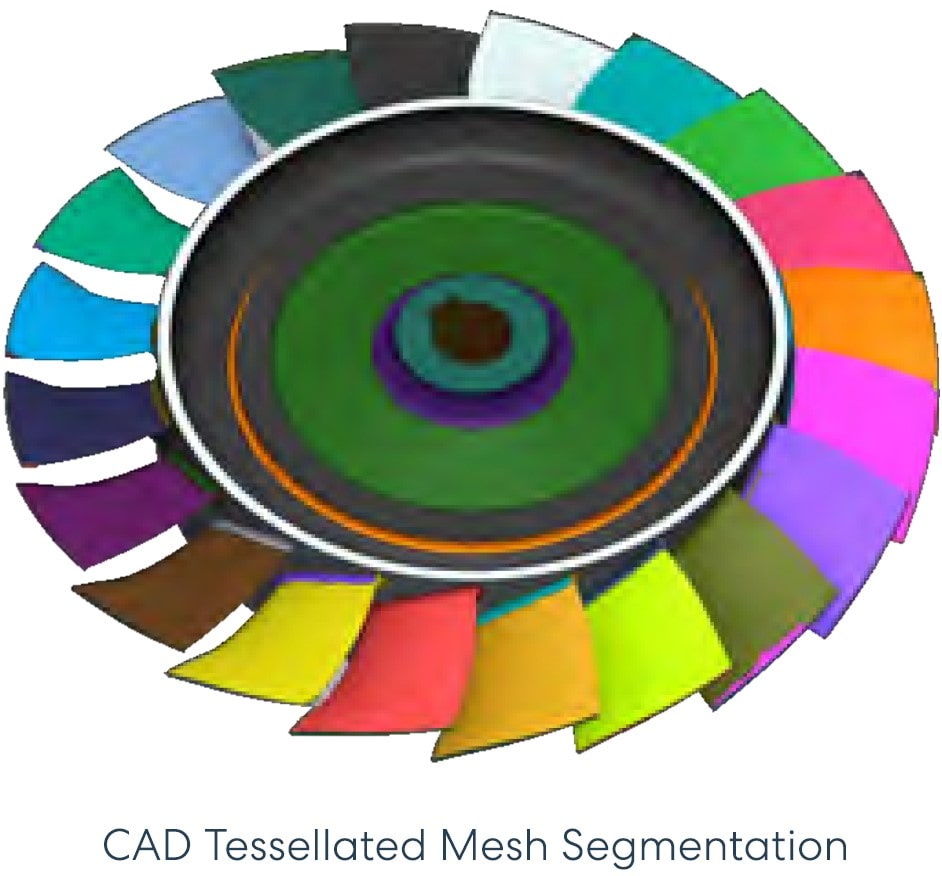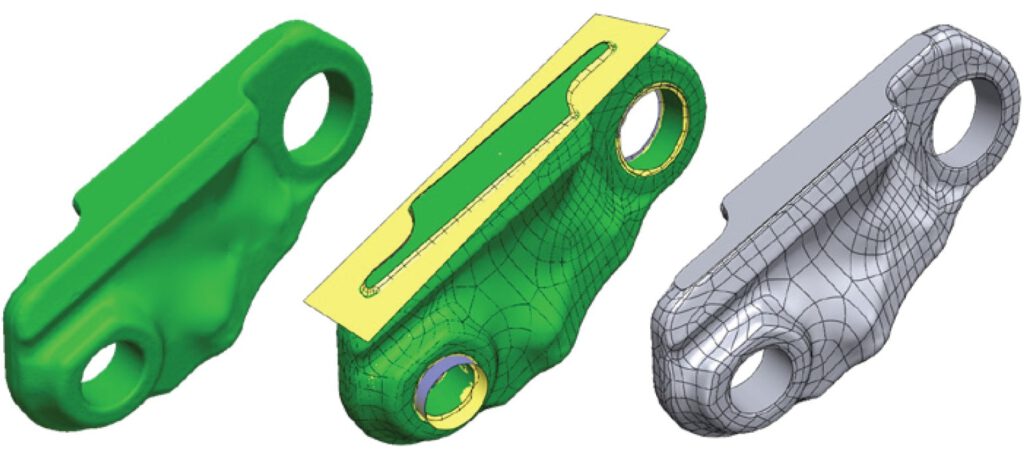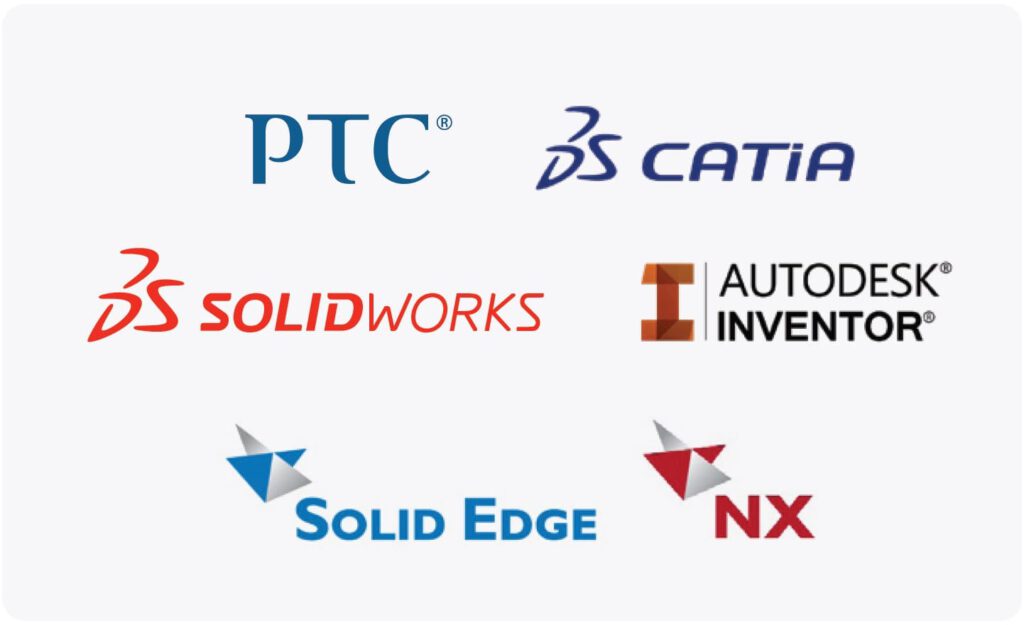[3D SCAN] ข้อมูลผลิตภัณฑ์: Geomagic Design X

About Reverse Engineering
มีหลายวิธีในการสร้าง 3D CAD จากข้อมูลที่ได้จากการสแกน 3 มิติ อธิบายอย่างคร่าวๆวิธีการมีดังนี้
การเตรียมข้อมูล:
แก้ไขข้อมูลการสแกน (STL mesh)
เคลียร์ข้อมูลการสแกนให้สวยงาม,เติมเต็มส่วนที่ขาดหาย,ลบจุดที่เป็นส่วนเกิน,การทําให้มีขนาดเล็ก เพื่อเพิ่มประสิทธิภาพตาข่าย ฯลฯ
พื้นผิว โดยวิธีการ ①, ② หรือ ③
① พื้นผิวอัตโนมัติ:
วัตถุประสงค์หลักคือการแปลงรูปแบบไฟล์เสแกน (ไฟล์ STL) โดยซอฟต์แวร์ 3D CAD อาจส่งผลให้เกิดความบกพร่องบนพื้นผิวซึ่งเป็นเรื่องยากหากจําเป็นต้องแก้ไข 3D โมเดลในอนาคต แต่ข้อดีคือสามารถสร้างข้อมูลได้ในเวลาอันสั้นด้วยคําสั่งเดียว
② ขอบเขตพื้นผิวที่เหมาะสม:
สร้างพื้นผิวโมเดล 3D CAD จากข้อมูลการสแกนด้วยซอฟต์แวร์หรือดําเนินการด้วยตนเอง ในบางครั้งเราทำการสร้างfilletsและส่วนที่เป็นรูด้วยเช่นกัน โมเดล 3 มิติที่ถูกสร้างขึ้นจึงมีความเหมือนและตรงตามรูปแบบไฟล์สแกน
③ การสร้างแบบจําลองย้อนกลับ:
ตัวอย่างเช่น หากขนาดของข้อมูลที่ได้จากการสแกนคือ 4.98 แต่โมเดลต้นฉบับอยู่ที่ 5 เราจึงต้องทำการปรับแก้ไข นอกจากนี้เรายังแก้ไขความไม่สอดคล้องในพื้นผิวของการเชื่อมต่อที่เกิดการเปลี่ยนแปลงด้วย และจะดีมากหากมี Drawing มาใช้เป็นข้อมูลในการอ้างอิงได้ การสร้างแบบจําลองนี้ข้อมูลที่ได้จะมีคุณภาพสูงใกล้เคียงกับโมเดล 3 มิติต้นฉบับ แต่ผู้ปฏิบัติต้องมีทักษะการทํา 3D CAD ในระดับหนึ่ง
เมื่อลูกค้าให้สร้างแบบจําลอง 3 มิติเราจะมีการพูดคุยหลายครั้งเพื่อทําความเข้าใจระดับคุณภาพข้อมูลที่ต้องการอย่างถูกต้องเกี่ยวกับวิธีการทํางานข้างต้น เช่นในกรณีของการสร้างแบบจําลอง 3 มิติของแม่พิมพ์ พื้นผิวของผลิตภัณฑ์จะถูกสร้างขึ้นตามข้อมูลการสแกนและเลือกใช้วิธีการ เช่นการสร้างแบบจําลองย้อนกลับโดยใช้ Drawing ในการอ้างอิงค่าและขนาด ไฟล์ของโมเดล 3 มิติที่ส่งให้เราอาจเป็นไฟล์ Parasolid, STEP หรือ IGES ในกรณีที่ลูกค้ามีซอฟต์แวร์ 3D CAD หากใช้ SOLIDWORKS และสามารถรับไฟล์ Parasolidได้เราขอแนะนําใช้ไฟล์ Parasolid
ซอฟต์แวร์งานวิศวกรรมย้อนกลับ | Geomagic Design X
เมื่อพูดถึงถึงซอฟต์แวร์งานวิศวกรรมย้อนกลับหลายคนจะนึกถึง Geomagic Design X ของ
3D Systems เพราะเป็นหนึ่งในซอฟต์แวร์ที่ใช้มากที่สุดในโลกและยังถูกใช้ในบริการของเราด้วย
นอกเหนือจากฟังก์ชั่นการสร้างแบบจําลองต่างๆที่กล่าวถึงข้างต้นแล้วเรายังมีอินเทอร์เฟซเต็มรูปแบบพร้อมซอฟต์แวร์ 3D CAD ที่สําคัญ ตัวอย่างเช่น LiveTransfer ของ Geomagic Design X ที่สามารถถ่ายโอนข้อมูลทั้งหมดหรือบางส่วนเช่นเรขาคณิต,Topology,ประวัติการสร้างแบบจําลองและพารามิเตอร์ของแบบจําลองพาราเมตริก 3 มิติไปยังCADซอฟต์แวร์เช่น Autodesk, AutoCAD, Autodesk Inventor, CATIA, PTC Creo, Siemens NX, Siemens Solid Edge หรือ SOLIDWORKS เป็นต้น โดยอัตโนมัติแบบเรียลไทม์
มีอะไรใหม่บ้างใน Geomagic Design X 2022
 Geomagic Design X เวอร์ชัน 2022 ได้มีการการออกแบบโลโก้ใหม่ ใช้ชื่อว่า Oqton ซึ่งเป็นชื่อของบริษัทที่ 3D Systems,Inc. เข้าซื้อกิจการในปี 2022
Geomagic Design X เวอร์ชัน 2022 ได้มีการการออกแบบโลโก้ใหม่ ใช้ชื่อว่า Oqton ซึ่งเป็นชื่อของบริษัทที่ 3D Systems,Inc. เข้าซื้อกิจการในปี 2022
เวอร์ชั่น 2022
 LiveTransfer ไปยังซอฟต์แวร์ CAD เวอร์ชันล่าสุด
LiveTransfer ไปยังซอฟต์แวร์ CAD เวอร์ชันล่าสุด
แอปพลิเคชั่น CAD เวอร์ชั่นดังกล่าวนี้จะถูกพิ่มเติมใน LiveTransfer:
• SOLIDWORKS 2022
• Inventor 2021, 2022, and 2023
• Creo 8.0, 9.0
• Creo Parametric 4.0 M150
• NX 1899, 1926, 1953 series
 การปรับปรุงเครื่องมือเขียนแบบ
การปรับปรุงเครื่องมือเขียนแบบ
ได้รับการปรับปรุงช่วยเพิ่มประสิทธิภาพการทํางานผ่านเครื่องมือเขียนแบบ:
• วาดสี่เหลี่ยมผืนผ้าตรงกลาง
• แทนที่ตาข่ายเป้าหมายเมื่อสร้างหรืออัปเดตร่างตาข่าย
• เลือกประเภทการแสดงผลสําหรับมิติวงกลม
• กําหนดข้อ จํากัด จุดกึ่งกลางระหว่างเส้น / ส่วนโค้งและจุด
 รองรับ สแกนเนอร์/โพรบ
รองรับ สแกนเนอร์/โพรบ
มีการรองรับฮาร์ดแวร์เพิ่มเติมใน Scanner Direct Control และ LiveCapture:
• สแกนวัตถุโดยตรงใน Design X โดยใช้อินเทอร์เฟซ Hexagon Structured Light Scanner
• รองรับ Scanner Direct Control สำหรับสแกนเนอร์ 3D Einscan Shining
• โดยใช้โพรบ Faro Quantum Max / S + LLP XR / HD
• ใช้ Leica AT960 tracker + Absolute AS1 สแกนเนอร์
 การปรับปรุงเครื่องมือสร้างแบบจําลอง
การปรับปรุงเครื่องมือสร้างแบบจําลอง
การปรับปรุง Loft และ Exact Surfacing Tools ช่วยให้คุณสามารถ:
• กําหนดตัวเชื่อมต่อเพื่อให้สามารถควบคุมคุณลักษณะของ Loft ได้มากขึ้น
• เลือกตัวเลือกแบบฟอร์มเพื่อควบคุมการสัมผัสสําหรับเส้นโค้งไกด์สําหรับคําสั่ง Surface Loft
• ประหยัดเวลาโดยนำเอาเครือข่าย auto-surface patch กลับมาใช้ใหม่เมื่อสร้าง surface patch ด้วยตนเอง
 การแบ่งส่วนพื้นที่
การแบ่งส่วนพื้นที่
ปรับปรุงคุณภาพของการแบ่งส่วนพื้นที่สําหรับตาข่าย tessellated จาก CAD ด้วยอัลกอริธึมการแบ่งส่วนพื้นที่ใหม่ใน Design X 2022
ตัวเลือก CAD Tessellation Mesh ที่เพิ่มเข้ามาใหม่ช่วยให้ สามารถแบ่งส่วนพื้นที่คุณภาพสูงของโมเดลตาข่าย CAD
เวอร์ชั่น 2020
 การเลือกแบบพื้นผิว
การเลือกแบบพื้นผิว
ความสามารถในการเลือกพื้นผิวใหม่ช่วยลดความซับซ้อนของ workflows ชิ้นส่วนที่ยากก่อนหน้านี้ในขณะที่เปิดใช้งาน workflows การสร้างแบบจําลองแบบไฮบริดคุณสมบัตินี้หมายถึงวิธีการสร้างพื้นผิวแบบอัตโนมัติที่รวดเร็วกับวิธีการสร้างแบบจําลองคุณสมบัติที่มีความแม่นยําสูง ส่งผลให้ CAD ที่นำกลับมาใช้ใหม่มีคุณภาพ ซึ่งช่วยให้โมเดลมีความแม่นยำและเพิ่มความเร็วในการผลิต
• พื้นผิวที่ล้อมรอบด้วยเส้นโค้ง – ช่วยให้คุณควบคุมตําแหน่งที่พื้นผิวถูกตัดแต่งได้มากขึ้น
• Surface Selected Meshes – เลือกพื้นผิวเฉพาะที่ต้องการได้อย่างรวดเร็วและง่ายดาย
 Unroll/Roll
Unroll/Roll
เครื่องมือใหม่ เช่นการคลี่ออกและม้วนทําให้การสร้างแบบจําลองของรูปทรงเรขาคณิตที่ซับซ้อนนั้นง่ายขึ้น โดยใช้เครื่องมือประมวลผลตาข่ายเพื่อกางตาข่ายและแยกภาพร่าง 2 มิติโดยอัตโนมัติทําการปรับเปลี่ยนที่จําเป็นและม้วนภาพร่างใหม่เพื่องานวิศวกรรม ความสามารถนี้ไม่เพียงแต่ช่วยลดการทําซ้ําและทําใหม่หลายครั้ง แต่ยังช่วยเพิ่มประสิทธิภาพความแม่นยําของชิ้นส่วนด้วย
 อัพเดทไฟล์ I/O
อัพเดทไฟล์ I/O
Geomagic Design X 2020 รวมถึงการปรับปรุงอินเทอร์เฟซ LiveTransfer ยังได้รับการอัปเดตเพื่อรองรับการเชื่อมต่อกับอุปกรณ์สแกนล่าสุดและเข้ากันได้กับ CAD เวอร์ชันล่าสุด
• Autodesk® Inventor® 2020
• CATIA® V5/V6 2019 (save as)
• PTC® Creo® 6
• Siemens Solid Edge® 2020
• Siemens® NX™ 1872
• SOLIDWORKS® 2020
 การแยกตาข่าย
การแยกตาข่าย
คุณสมบัติใหม่ทําให้ง่ายต่อการแยกวัตถุตาข่ายเดียวออกเป็นแต่ละองค์ประกอบทําให้ง่ายต่อการประมวลผลการพิมพ์ 3 มิติ
 การแยกขอบเขต
การแยกขอบเขต
เส้นโค้งที่กำหนดโดยคําสั่งขอบเขตสามารถระบุได้อย่างชัดเจนว่าเป็น “เส้นโค้งขอบเขต” ซึ่งจะช่วยในการปรับปรุงคุณภาพพื้นผิว
เพิ่มประสิทธิภาพพื้นผิว
เวอร์ชั่นล่าสุดได้รับการปรับความเร็วในส่วนของSurface Fit
• auto Surface เร็วขึ้น 36%
• fit surface patches เร็วขึ้น 28%
การเปรียบเทียบคุณสมบัติ Geomagic Design X ตามรุ่น
| คุณสมบัติ | Design X Essentials | Design X |
|---|---|---|
| Import neutral file formats | ✔ | ✔ |
| Extract sectional polylines or silhouette polylines from mesh or point cloud | ✔ | ✔ |
| Create sketch entities based on extracted polylines | ✔ | ✔ |
| Create 3D sketch entities | ✔ | ✔ |
| Mesh processing tools | ✔ | ✔ |
| Create reference geometry | ✔ | ✔ |
| Create solid bodies | ✔ | ✔ |
| Create surface bodies | ✔ | ✔ |
| Basic modeling features | ✔ | ✔ |
| Manual region creation tools | ✔ | ✔ |
| Align meshes or point clouds to other meshes or point clouds | ✔ | ✔ |
| Interactively align mesh using multiple methods | ✔ | ✔ |
| Measurements between entities | ✔ | ✔ |
| Real-time deviation analysis to compare bodies, curves, sketches or meshes with a base entity | ✔ | ✔ |
| Basic selection tools | ✔ | ✔ |
| Automatically create curve networks on the mesh and fit surface patches | ✔ | ✔ |
| Native CAD Importer/Exporter | ✔ | |
| Automatically create sketch entities from section of meshes and point clouds | ✔ | |
| Create 2D sketch independent of a section of meshes and point clouds | ✔ | |
| Create more types of 2D and 3D sketch entities | ✔ | |
| 3D Sketch on the Mesh | ✔ | |
| Wizard for creating mesh models from multiple raw 3D scan data | ✔ | |
| Advanced mesh processing tools | ✔ | |
| Wizard to align a mesh to a desired set of coordinates | ✔ | |
| Automatic alignment methods | ✔ | |
| Transfer design and feature tree to standard CAD software products | ✔ | |
| Plan a series of commands with parameters and run them | ✔ | |
| Execute a series of jobs on a computer without manual intervention | ✔ | |
| Selection techniques based on model properties | ✔ | |
| Automatically create features from a mesh using Modeling Wizard | ✔ | |
| Reform features on an existing design based on reference scan data | ✔ | |
| Advanced surface modeling tools | ✔ | |
| Body/Face editing tools | ✔ | |
| Create surface for a specific portion of the mesh using Auto-Surface | ✔ | |
| Extract a high-quality freeform surface body from a complex mesh | ✔ | |
| Portable metrology device support and tools | ✔ | |
| Direct plugin scanning | ✔ | |
| Automatically classify feature regions by recognizing 3D features from scan data | ✔ | |
| Automatic region modification tools | ✔ | |
| Process point clouds and convert them to a mesh | ✔ | |
| Edit and manage colors and textures on a mesh or point cloud | ✔ | |
| Detect defects on solid and surface bodies | ✔ | |
| Check deviation between meshes and point clouds | ✔ |
เราให้บริการงานวิศวกรรมย้อนกลับและการใช้งานซอฟต์แวร์ โปรดอย่าลังเลที่จะติดต่อเราหากคุณสนใจ
[ ดาวน์โหลด แคตตาล็อก ]
Geomagic Design X Catalog – English
Geomagic Design X Versions Features Comparison – English
แบบฟอร์มติดต่อ:
ติดต่อ:
วีนัส โภคทรัพย์ (มือถือ: 087 087 2561)
วิภาวี เสวตวิหารี (มือถือ: 083 064 6976)
โรบิน เซอิโนะ (มือถือ: 083 064 2112)
